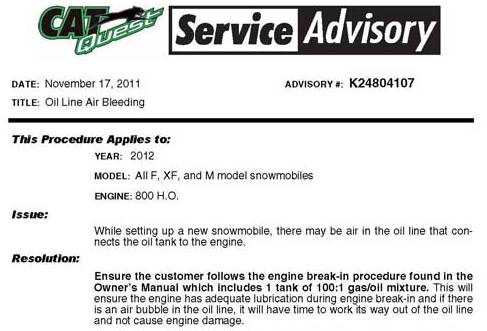
In the wake of a handful of engine burndowns in Alaska and Canada, this last week Arctic Cat sent a Service Advisory to its dealers concerning proper set-up of all 2012 F, XF and M 800s.
This is not…I repeat NOT a bulletin or recall. On the contrary, it’s a bulletin that simply reminds dealers of the proper set-up of all 800s before leaving the dealership as well as the need for customers to run a 100:1 gas/oil mixture in the first full tank of full.
Arctic Cat is investigating the handful of burndowns, and from all accounts it appears to be a problem of air-bubbles in the oil and, likely, not running a 100:1 fuel/oil pre-mixture in the first tank of gas.
Although this has happened to a few 2012 800s, this isn’t exactly a new problem with oil-injected sleds. Fill the oil reservoir on any injected sled with new oil and air bubbles can/will exist in the system until the machine has been run for a few hours. An air bubble moving through the lines and into the case will create a brief moment when there is no oil lubricating the crank and cylinders. When this happens burndown can (will) occur if there is no additional oil lubrication.
Which is why for decades Arctic Cat has required that owners run the 100:1 premix in the entire first full tank of fuel. It ensures adequate lubrication in the event of an air bubble and optimizes engine break-in.
I’m told by Arctic Cat’s Service department that when following proper procedure, the company has not been able to replicate the burndown scenario experienced by a small number of owners. The company believes the problem is that customers haven’t added oil to the first tank of fuel.
Owners (or dealers) can expedite the process of bleeding air from the oil system by tipping the machine on its left side for 5 minutes (engine off), with the cap removed from the top of a fuel reservoir of oil. You must still run 100:1 premix in the first tank, however.
With a 10.8-gallon fuel tank, this means that owners must add 13 oz. of oil to the fuel and burn most of this supply before adding more fuel.
CLICK HERE to download a pdf of the Service Advisory.
